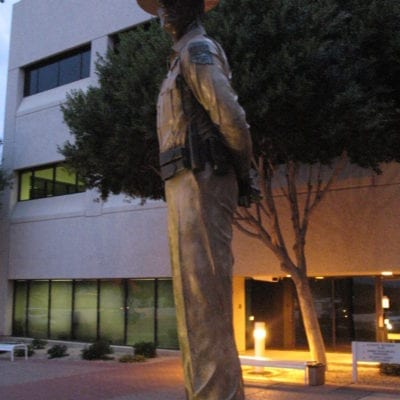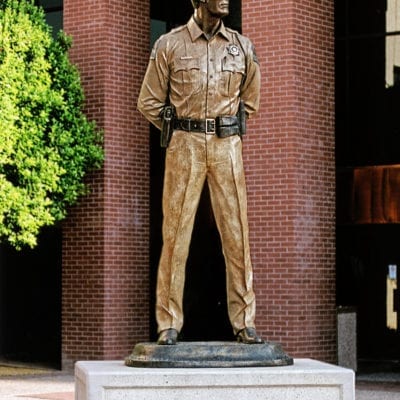- OIS question: Is a “non-threatening” gun really non-threatening?
II. New study: Who kills cops?
III. Recommended reading: A Chief’s view on advocating for law enforcement - OIS question: Is a “non-threatening” gun really non-threatening?
Part of a continuing series of Force Science successes
In our last edition, we reported on a new study about the speed of getting from a ready position to shots fired in target alignment.
Today we bring that issue into the courtroom, with a real-life case in which a graduate of the Force Science certification course helped exonerate an officer and his municipality of wrongdoing in a fatal shooting.
The question at hand: Can an armed suspect who is holding an AR-15 in a “non-threatening” position outshoot an officer who already has his gun drawn?
DEADLY DOMESTIC. The shooting occurred in Elgin, a hamlet of fewer than 500 families that sits at a highway crossroads in the wheat and cattle country of northeastern Oregon. At 0730 that fateful August Monday in 2011, the town’s police chief was honeymooning in the Caribbean and the only other full-time officer was asleep at home when the dispatcher rousted him with the report of a domestic in progress at the residence of a local environmental clean-up specialist and general contractor.
At the scene, the officer found that the contractor’s wife was trying to leave him, hauling belongings out of their house, but the 60-year-old husband was angrily blocking her path. “The living room was in disarray, its floor littered with papers, articles of clothing, and other items of all kinds,” a report later noted. Tempers were hot.
The officer advised the husband not to interfere and turned to talk to the wife. Out of the corner of his eye, he then caught sight of a sudden change in the dynamics. The husband “apparently had reached down next to a reclining chair” and now stood up holding an AR-15 “in a firing grip” in a port-arms position.
The officer drew his .45-cal. Glock 21, pointed it at the suspect, and yelled at him repeatedly to “drop the gun!” He didn’t. Holding the pistol in his right hand, the officer drew his Taser with his left and discharged it at the suspect. The probes missed. The officer moved in and tried a drive stun to the neck. The suspect deflected the Taser with the rifle barrel and the officer dropped the device. Snapping, “Give me that,” the officer then grabbed the barrel of the rifle and with his left hand tried to wrest the gun away from the suspect. The older man proved surprisingly strong and maintained his grip.
Finally, when the muzzle pointed at his face for the second time during their struggle, the officer squeezed off five rounds in rapid succession from his .45. Hit with each, the suspect fell back into the recliner, “twitching and dying.”
OVERREACTION? The officer, the chief, and the town of Elgin were named in a federal civil rights suit brought by the suspect’s widow. Alleging unreasonable force, poor supervision, and inadequate training, the plaintiff demanded damages of $10.5 million.
The defendants’ attorneys, Steven Kraemer and Leslie Edenhofer of Portland, called on Emanuel Kapelsohn, a certified Force Science analyst from Pennsylvania, to help in preparing and presenting their case. Kapelsohn, a graduate of Yale University, Harvard Law School and an active reserve officer, is widely recognized as a top-notch expert witness and law enforcement trainer of firearms, tactics, and use of force, with more than 35 years’ experience.
As the case moved through its preliminary stages, two consultants hired by the plaintiff’s legal team took the position that the officer had overreacted in confronting the armed suspect and thereby unnecessarily escalated the situation to a fatal level, Kapelsohn told Force Science News. “They claimed that the officer should have left the scene when he realized no physical fight was going on,” he says.
One consultant, a CJ professor and former cop, insisted in a pre-trial report that because the suspect initially held the AR-15 in a port-arms position the gun was “no threat.” The officer, having drawn and pointed his pistol at the subject “had the drop” on him, the consultant said, an advantage he characterized as “the crown jewel of police tactics.” The officer, he said, had “complete control” of the situation.
The other consultant, an investigator and DT instructor for a security training firm, stated in his report that in order for the suspect to shoot the officer, he would have had to “engage in at least six mechanical indexes, or separate motions, to maneuver the AR-15 from port-arms to a point where deadly force could be used against anyone.” This manipulation, according to the consultant, would have bought the officer, with his gun already out and pointed, plenty of time to react.
“He made it sound like something you could time with a sundial,” Kapelsohn says. Kapelsohn considered this reasoning preposterous.
TIMED FIRING. At a shooting range, Kapelsohn’s wife videoed him activating an AR-15 in response to the buzzer on an electronic timer. “Starting with the rifle in the port-arms position, safety engaged and my finger outside the trigger guard, I moved the gun down as fast as I could and fired a shot into the upper chest of a silhouette training target about five feet in front of me,” Kapelsohn says.
“In three tries, my average time was 0.63 seconds. If I was willing to accept a head shot without bringing the muzzle fully down to the chest level of the target, I was able to do it in under half a second. Starting with the safety off, it presumably would have been even easier and faster.
“The timing included my reaction time to the buzzer, about 0.25 seconds. So in a real situation, with the suspect initiating the action and thus eliminating any reaction time on his part, he could move, point, and fire the rifle in about 0.38 seconds. With the time it would likely take for the officer to perceive the suspect starting to move, process this information, and get off his first defensive round, he might end up with a tie at best.
“And of course there would always be the possibility that the officer’s first shot might miss or might hit the suspect but fail to incapacitate him immediately.”
As Kapelsohn told the attorneys: “Once [the suspect] picked up the rifle, [the officer] was already on the losing side of the reaction-time curve, as [the suspect] could, if he so chose, shoot [the officer] before [the officer] could effectively react to stop him.”
Thus, Kapelsohn said, the officer’s unsuccessful attempts to get the suspect disarmed and then finally escalating to shooting him were not evidence of “overreaction” but justifiable efforts to eliminate the risk of himself being slain. “In the context of a domestic dispute,” Kapelsohn said, “a non-compliant individual who picks up and then refuses to relinquish control of a rifle to a police officer is a deadly threat.”
In addition to the video demo, Kapelsohn in his extensive report to the defense team referenced a variety of other material from his Force Science training, including studies explaining the inevitability of officers firing multiple rounds in life-threatening situations, the auditory and visual exclusions that can explain why officers may not recall all details of a shooting, and the nature of falling patterns that enable a suspect to continue being a threat even while going down from lethal wounds.
IN COURT. When the civil suit went to trial last January in the U.S. District Court in Pendleton (OR), Magistrate Judge Patricia Sullivan did not make it easy for Kapelsohn to get some of his information before the jury.
She would not permit his video to be shown, for example, ruling enigmatically that it was not “realistic” because an electronic timer had been used! Nor would she allow the suspect’s AR-15 (or any other AR-15) to be brought into the courtroom so that Kapelsohn could demonstrate with the actual gun or type of gun involved.
She did, however, permit him to testify about his tests and to use a molded-plastic, red training rifle to show a crude depiction of how fast the suspect could have brought the AR-15 from port arms to firing position, thus countering claims of the plaintiff’s experts that the officer had been in no danger initially.
The trial lasted four days, with Kapelsohn the last defense witness. The jury was out just one hour, including the time it took to select their foreperson. When they returned, they brought in a verdict in favor of the defense.
More than three years had passed since the shooting. During that time, the chief and the involved officer resigned and the town of Elgin eliminated its police department. The community now pays for contract police service through the county sheriff’s office.
Emanuel Kapelsohn can be reached in Fogelsville, PA, through his firm, The Peregrine Corporation: phone 610-360-7053; email peregrine@ptd.net
- New study: Who kills cops?
The recent national tumult about police officers killing suspects got a medical professor with an interest in murder thinking about the flip side of the equation–suspects who kill cops. What are the traits and trends of offenders who gun down LEOs, beyond what we already know from the FBI’s annual stats?
Dr. Michael Stone is a physician at a New York forensic psychiatric hospital, teaches at the Columbia College of Physicians & Surgeons, and once hosted a Discovery Channel show about murderers, called “Most Evil.”
He studied 66 US cases in which officers were deliberately slain on the job across a recent two-year period and last month published his findings in the journal Violence and Gender. You can access his study until Apr. 18, by clicking here
Among other things, he offers these observations from his small sample:
- 75% of the killers were from 18 to 37, the segment of the lifespan that sees the rise, peak, and beginning decline of testosterone concentration in males (there were no female killers in the study period). This is true as well “with mass murderers (an almost entirely male group) and actually with male murderers in general,” Stone writes. The average age of cop killers within this age span was 22 for blacks, 29 for whites.
- Another age-related factor, Stone suggests, is that key areas of the brain related to “inhibitory control and social decision-making”–the brain’s “braking system,” so to speak–are “not fully in operation” until the early 20s.
“This helps account for the comparative impulsivity, recklessness, and daring-do of adolescents,” Stone explains. Unlike many other murderers, he says killers of police tend not to plan their slayings but act “impulsively on the spur of the moment,” some how imagining they can “get away with it, even though it is common knowledge (even among the young) that [police] will hunt to the ends of the earth” to apprehend those who kill one of their own.
- About one in eight of Stone’s cop killers “could reasonably be placed within the spectrum of psychiatric disorders.” Paranoid tendencies seemed most common. As a group, cop killers appear “only half as likely to suffer from an obvious schizophrenic or other psychoses as do mass murderers,” he reports.
His data pool did not permit him to explore it, but Stone is intrigued by the possibility that a “history of severe head injury in the early decades of life” might influence fatal attacks on officers. Such injury, he says, “figures importantly in the background of many murderers” because it is “often followed by profound personality changes, [including] impulsivity, poor decision-making, and lack of emotional control.”
- As to race, blacks were disproportionately represented in Stone’s sample, as they are in crime statistics generally. While comprising less than 13% of our population, blacks constituted 37% of cop killers in 2013 and 26% in 2014, he writes.
- The majority of those killing officers had criminal records and most commonly the slayings occurred when officers were trying to question their attacker about some suspicious activity or to make an arrest. After the murders, about half then committed suicide or were killed by other officers–“not statistically different,” Stone points out, from the ends experienced by mass murderers.
Lt. Glen Mills of the Burlington (MA) PD brought this study to our attention. Commenting on Stone’s conclusion that cop killing is so often an impulsive act, Mills says: “It is important in officer survival training to find out what can be done in these impulsive situations to lower the risk. Officers being polite, ‘squared away,’ and waiting for backup might be even more important than we thought.”
Dr. Stone can be reached at: michaelhstonemd@gmail.com
III. Recommended reading: A Chief’s view on advocating for law enforcement
Deputy Chief William Mazur with Atlantic City PD, a recent graduate of the Force Science Certification Course, has written an excellent opinion piece titled, The Time Is Now: Why this police chief believes every cop must be an advocate for law enforcement.
The article was recently published by Calibre Press in their Street Survival Newsline and is now available online at: http://calibrepress.com/2015/03/the-time-is-now/
It’s a good read! Check it out.






